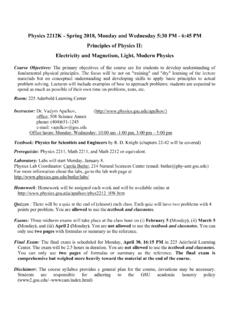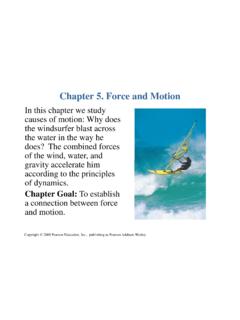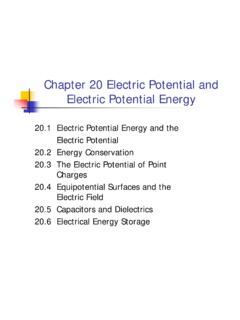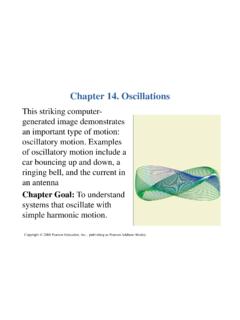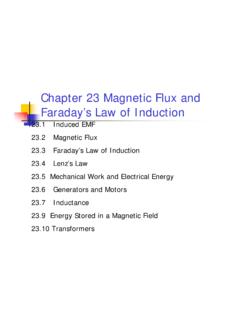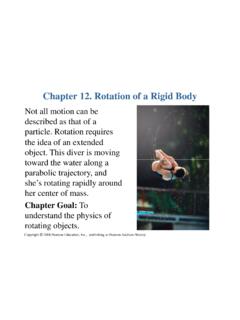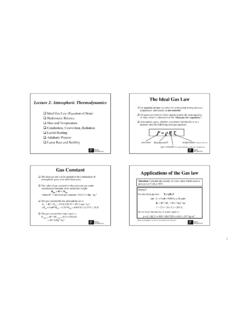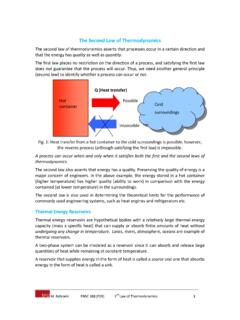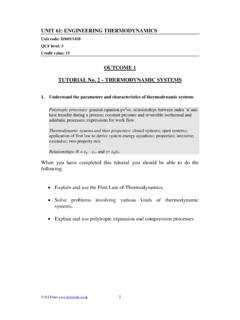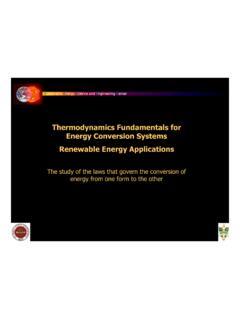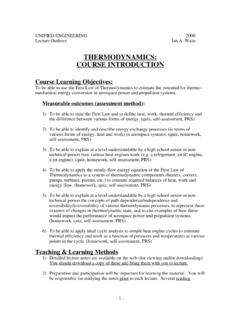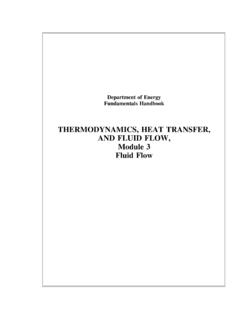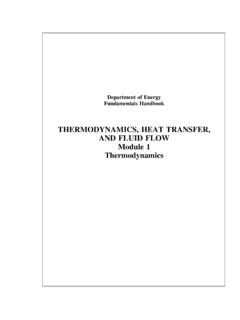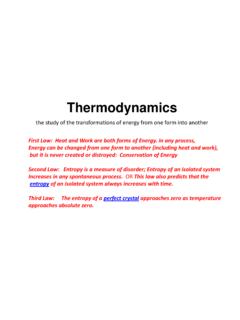Transcription of Chapter 17. Work, Heat, and the First Law of Thermodynamics
1 Chapter 17. Work, heat , and the First Law of Thermodynamics This false-color thermal image (an infrared photo) shows where heat energy is escaping from a house. In this Chapter we investigate the connection between work and 2008 Pearson Education, Inc., publishing as Pearson work and Goal:To expand our understanding of energyand to develop the First law of Thermodynamics as a general statement of energy : It s All About Energy Work in Ideal-Gas Processes heat Chapter 17. Work, heat , and the First Law of of ThermodynamicsThermodynamicsCopyright 2008 Pearson Education, Inc., publishing as Pearson Addison-Wesley. The First Law of Thermodynamics Thermal Properties of Matter Calorimetry The Specific Heats of Gases heat -Transfer MechanismsChapter 17.
2 Reading QuizzesCopyright 2008 Pearson Education, Inc., publishing as Pearson 17. Reading QuizzesWhat quantities appear in the First law of Thermodynamics ?A. force, mass, accelerationB. inertia, torque, angular momentumC. work, heat , thermal , heat , entropyCopyright 2008 Pearson Education, Inc., publishing as Pearson , heat , entropyE. enthalpy, entropy, heatWhat quantities appear in the First law of Thermodynamics ?A. force, mass, accelerationB. inertia, torque, angular momentumC. work, heat , thermal , heat , entropyCopyright 2008 Pearson Education, Inc., publishing as Pearson , heat , entropyE. enthalpy, entropy, heatWhat was the original unit for measuring heat ?A. BTUB. 2008 Pearson Education, Inc.
3 , publishing as Pearson PascalE. CalorieWhat was the original unit for measuring heat ?A. BTUB. 2008 Pearson Education, Inc., publishing as Pearson PascalE. CalorieWhat is the name of an ideal-gas process in which no heat is transferred? A. IsochoricCopyright 2008 Pearson Education, Inc., publishing as Pearson IsentropicC. IsothermalD. IsobaricE. AdiabaticWhat is the name of an ideal-gas process in which no heat is transferred? A. IsochoricCopyright 2008 Pearson Education, Inc., publishing as Pearson IsentropicC. IsothermalD. IsobaricE. AdiabaticHeat isA. the amount of thermal energy in an object. B. the energy that moves from a hotter object to a colder object. fluid-like substance that flows from Copyright 2008 Pearson Education, Inc.
4 , publishing as Pearson fluid-like substance that flows from a hotter object to a colder both A and both B and isA. the amount of thermal energy in an object. B. the energy that moves from a hotter object to a colder fluid-like substance that flows from Copyright 2008 Pearson Education, Inc., publishing as Pearson fluid-like substance that flows from a hotter object to a colder both A and both B and thermal behavior of water is characterized by the value of itsA. heat 2008 Pearson Education, Inc., publishing as Pearson specific thermal thermal behavior of water is characterized by the value of itsA. heat 2008 Pearson Education, Inc., publishing as Pearson specific thermal 17.
5 Basic Content and ExamplesCopyright 2008 Pearson Education, Inc., publishing as Pearson 17. Basic Content and ExamplesWork in Ideal-Gas ProcessesConsider a gas cylinder sealed at one end by a moveable 2008 Pearson Education, Inc., publishing as Pearson in Ideal-Gas ProcessesIf we let the piston move in a slow quasi-static process from initial volume Vito final volume Vf, the total work done by the environment on the gas isCopyright 2008 Pearson Education, Inc., publishing as Pearson , graphicallyProblem-Solving Strategy: Work in Ideal-Gas ProcessesCopyright 2008 Pearson Education, Inc., publishing as Pearson Strategy: Work in Ideal-Gas ProcessesCopyright 2008 Pearson Education, Inc.
6 , publishing as Pearson Strategy: Work in Ideal-Gas ProcessesCopyright 2008 Pearson Education, Inc., publishing as Pearson Strategy: Work in Ideal-Gas ProcessesCopyright 2008 Pearson Education, Inc., publishing as Pearson in Ideal-Gas ProcessesIn an isochoric process, when the volume does not change, no work is an isobaric process, when pressure is a constant and the volume changes by V = Vf Vi, the work done during the process isCopyright 2008 Pearson Education, Inc., publishing as Pearson isIn an isothermal process, when temperature is a constant, the work done during the process isEXAMPLE The work of an isothermal compressionQUESTION:Copyright 2008 Pearson Education, Inc., publishing as Pearson The work of an isothermal compressionCopyright 2008 Pearson Education, Inc.
7 , publishing as Pearson The work of an isothermal compressionCopyright 2008 Pearson Education, Inc., publishing as Pearson The work of an isothermal compressionCopyright 2008 Pearson Education, Inc., publishing as Pearson , Temperature, and Thermal Energy Thermal energyEthis an energy of the system due to the motion of its atoms and molecules. Any system has a thermal energy even if it is isolated and not interacting with its environment. The units of Ethare Joules. HeatQ is energy transferred between the system and Copyright 2008 Pearson Education, Inc., publishing as Pearson Addison-Wesley. HeatQ is energy transferred between the system and the environment as they interact.
8 The units of Qare Joules. TemperatureTis a state variable that quantifies the hotness or coldness of a system. A temperature difference is required in order for heat to be transferred between the system and the environment. The units of Tare degrees Celsius or First Law of ThermodynamicsWork and heat are two ways of transfering energy between a system and the environment, causing the system s energy to change. If the system as a whole is at rest, so that the bulk mechanical energy due to translational or rotational motion is zero, then the Copyright 2008 Pearson Education, Inc., publishing as Pearson or rotational motion is zero, then the conservation of energy equation isTemperature Change and Specific HeatThe amount of energy that raises the temperature of 1 kg of a substance by 1 K is called the specific heatof that substance.
9 The symbol for specific heat is W= 0, so no work is done by or on the system, then the heat needed to bring about a temperature change TisCopyright 2008 Pearson Education, Inc., publishing as Pearson needed to bring about a temperature change TisTemperature Change and Specific HeatCopyright 2008 Pearson Education, Inc., publishing as Pearson Quenching hot aluminum in ethyl alcoholQUESTION:Copyright 2008 Pearson Education, Inc., publishing as Pearson Quenching hot aluminum in ethyl alcoholCopyright 2008 Pearson Education, Inc., publishing as Pearson Quenching hot aluminum in ethyl alcoholCopyright 2008 Pearson Education, Inc., publishing as Pearson Quenching hot aluminum in ethyl alcoholCopyright 2008 Pearson Education, Inc.
10 , publishing as Pearson Change and heat of TransformationA phase changeis characterized by a change in thermal energy without a change in temperature. The amount of heat energy that causes 1 kg of substance to undergo a phase change is called the heat Copyright 2008 Pearson Education, Inc., publishing as Pearson to undergo a phase change is called the heat of transformationof that symbol for heat of transformation is L. The heat required for the entire system of mass Mto undergo a phase change isPhase Change and heat of TransformationTwo specific heats of transformation are the heat of fusionLf, the heat of transformation between a solid and a liquid, and the heat of vaporizationLv, the heat of transformation between a liquid and a gas.

